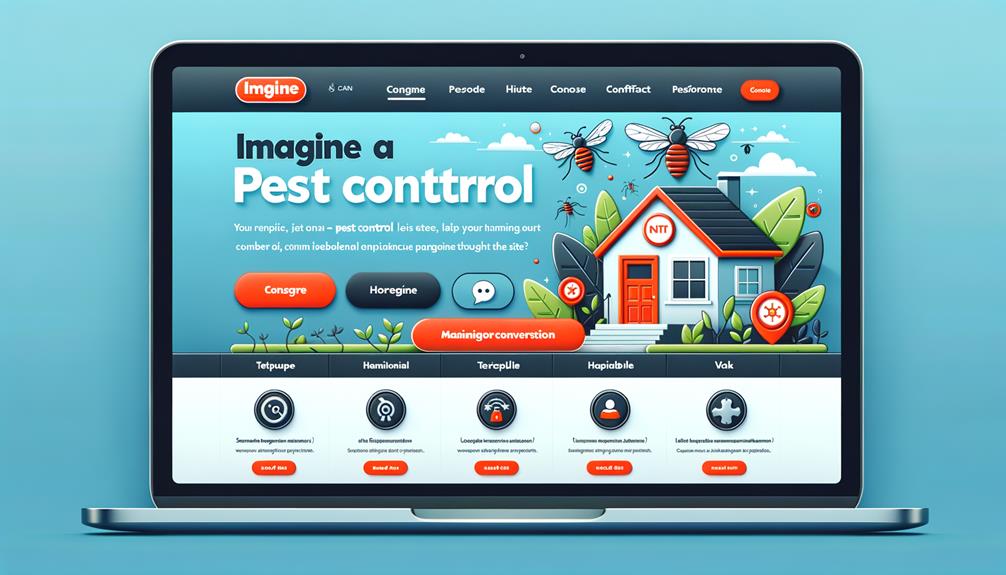Are you struggling to convert website visitors into paying customers? Wondering how you can optimize your pest control website to increase conversions? Look no further.
In this discussion, we will explore ten practical steps that can help you optimize your pest control website and improve your conversion rates. From understanding your target audience to implementing persuasive testimonials and reviews, these steps will provide you with valuable insights and actionable strategies to drive more conversions and grow your business.
So, if you’re ready to take your pest control website to the next level, let’s dive in.
Table of Contents
ToggleKey Takeaways
- Conduct thorough target market analysis and customer profiling to understand the demographics and psychographics of the target audience.
- Optimize website structure and navigation by simplifying the menu, grouping related content, and implementing search functionality and breadcrumbs.
- Craft compelling call-to-action buttons using eye-catching colors, compelling visuals, clear and concise language, and action-oriented words.
- Enhance user experience by ensuring website compatibility, improving loading speed, creating high-quality and informative content, and incorporating relevant keywords for search engine visibility.
Understand Your Target Audience

To optimize your pest control website for conversions, it’s crucial to understand your target audience. Conducting a thorough target market analysis and customer profiling will provide valuable insights that can help you tailor your website to meet the needs and preferences of your potential customers.
Start by identifying the demographics of your target market. Consider factors such as age, gender, location, and income level. This information will help you create content that resonates with your audience and addresses their specific concerns.
Next, delve deeper into the psychographics of your target audience. Understand their motivations, interests, and pain points. This knowledge will enable you to craft compelling messaging that speaks directly to their needs.
Furthermore, analyze your competitors to identify gaps in the market and differentiate yourself. Look for what they’re doing well and where they’re falling short. By understanding your competition, you can position your pest control services as the superior choice for your target audience.
Conduct Keyword Research
Understanding your target audience is the foundation for effective keyword research in optimizing your pest control website for conversions. Conducting keyword research allows you to identify the specific words and phrases that your potential customers are using when searching for pest control services. By incorporating these keywords into your website content, you can improve your visibility in search engine results and attract more targeted traffic.
To begin your keyword research, start by conducting a competition analysis. This involves identifying the keywords that your competitors are ranking for and analyzing their search volume and competitiveness. By understanding what keywords your competitors are targeting, you can gain valuable insights into the keywords that are driving traffic and conversions in your industry.
Once you have identified the keywords that your target audience is using and the keywords that your competitors are ranking for, you can focus on on-page optimization. This involves optimizing your website content, meta tags, and URLs with your target keywords. By strategically placing your keywords in these areas, you can improve your website’s relevancy and increase its chances of ranking higher in search engine results.
Optimize Website Structure and Navigation

Ensure that your website has a well-organized structure and user-friendly navigation to optimize conversions. A clear and intuitive website design is crucial for attracting and engaging users, ultimately leading to higher conversion rates.
Here are three essential steps to optimize your website structure and navigation:
- Simplify your menu: Streamline your website’s menu by eliminating unnecessary pages and grouping related content together. This will make it easier for visitors to find what they’re looking for and navigate through your site effortlessly.
- Implement a search functionality: Incorporating a search bar on your website allows users to quickly find specific information or services they need. This improves user engagement and saves their time, enhancing their overall experience on your site.
- Use breadcrumbs: Breadcrumbs provide users with a clear path of the pages they’ve visited, making it easier for them to navigate back to previous pages or explore related content. Breadcrumbs also improve website structure and help search engines understand the hierarchy of your site.
Craft Compelling and Clear Call-To-Action Buttons
Craft captivating and concise call-to-action buttons to drive conversions on your pest control website.
When it comes to optimizing your website for better conversions, compelling visuals and effective copywriting are key elements to consider.
Your call-to-action buttons should stand out and entice visitors to take action. Start by using eye-catching colors that contrast with your website’s color scheme. This will draw attention to the buttons and make them more noticeable.
Additionally, incorporate compelling visuals that relate to your pest control services, such as images of pests or before-and-after pictures of clean and pest-free environments.
In terms of copywriting, keep your call-to-action buttons clear and concise. Use action-oriented words that convey a sense of urgency, such as ‘Get a Free Quote Now’ or ‘Book Your Appointment Today.’
Avoid using generic phrases like ‘Click Here’ or ‘Learn More’ as they don’t provide a clear indication of what action the user should take. Instead, be specific and highlight the value or benefit the user will receive by clicking the button.
Improve Website Loading Speed

Is your pest control website taking too long to load?
It’s time to optimize its speed for a better user experience.
By implementing speed optimization techniques, you can ensure that your website loads quickly and efficiently.
This will keep visitors engaged and increase conversion rates.
Speed Optimization Techniques
To enhance the loading speed of your pest control website, employ effective speed optimization techniques. A slow-loading website can frustrate visitors and lead to high bounce rates. Here are three speed optimization techniques to improve user engagement and conversions:
- Optimize images: Compress and resize images to reduce file sizes without sacrificing quality. Use image formats like JPEG or WEBP that offer better compression.
- Minify CSS and JavaScript: Remove unnecessary characters, spaces, and comments from your code to reduce its size. This will help your website load faster.
- Utilize caching: Enable browser caching to store static files on visitors’ devices, reducing the need for repeated downloads. This can significantly improve loading speed.
Enhancing User Experience
Improve your website’s loading speed to enhance user experience. A slow-loading website can be frustrating for users and may cause them to leave before even experiencing what your pest control business has to offer.
By improving accessibility and optimizing images, you can significantly enhance the loading speed of your website. To improve accessibility, ensure that your website is compatible with different devices and browsers.
Additionally, optimize images by compressing them without compromising on quality. Large image files can significantly slow down your website’s loading speed.
Create High-Quality and Informative Content
When it comes to optimizing your pest control website for conversions, creating high-quality and informative content is crucial.
Your content serves as a reflection of your expertise and professionalism, and it can greatly influence a visitor’s decision to take action.
Content Importance
Creating high-quality and informative content is crucial for optimizing pest control websites for conversions. Your website’s content is what attracts and engages visitors, and it plays a significant role in converting them into customers.
To ensure your content is effective in driving conversions, consider the following:
- Keyword optimization: Incorporate relevant keywords into your content to improve your website’s visibility on search engines. This will help attract more organic traffic and increase your chances of converting visitors into customers.
- Clear and concise messaging: Make sure your content is easy to understand and delivers your message clearly. Avoid using jargon or complex language that might confuse or alienate your audience.
- Engaging visuals: Include high-quality images, videos, and infographics to enhance your content and make it more engaging. Visuals can help convey information quickly and effectively, capturing the attention of your visitors and encouraging them to stay on your website longer.
Informational Content
To effectively optimize your pest control website for conversions, crafting high-quality and informative content is key.
When it comes to creating informational content, it’s important to incorporate engaging visuals and effective storytelling. By including visually appealing images, videos, or infographics, you can capture the attention of your website visitors and make your content more interesting and memorable.
Additionally, using effective storytelling techniques can help you connect with your audience on a deeper level and create a sense of trust and credibility. Whether it’s sharing success stories, providing educational resources, or offering expert advice, informational content that’s well-crafted and engaging won’t only attract more visitors to your website but also increase the likelihood of converting them into customers.
Implement Mobile-Friendly Design

Consider optimizing your pest control website with a mobile-friendly design. In today’s digital age, where mobile devices are becoming the primary means of accessing the internet, it’s crucial to ensure that your website is optimized for mobile users. A mobile-friendly design, also known as responsive design, allows your website to adapt and provide an optimal viewing experience across various devices, including smartphones and tablets.
Here are three reasons why implementing mobile optimization is essential for your pest control website:
- Improved user experience: A mobile-friendly design ensures that your website is easy to navigate, read, and interact with on mobile devices. It eliminates the need for users to zoom in or scroll horizontally, providing a seamless and enjoyable browsing experience.
- Increased visibility and reach: With more and more people using their smartphones to search for local businesses, a mobile-friendly website can help you reach a wider audience. It also improves your website’s visibility in search engine results, as search engines prioritize mobile-friendly websites.
- Higher conversion rates: A mobile-friendly design can significantly impact your website’s conversion rates. With a user-friendly interface and easy-to-use forms, mobile users are more likely to engage with your website and take action, such as requesting a quote or scheduling a service.
Utilize Persuasive Testimonials and Reviews
When it comes to optimizing your pest control website for conversions, one effective strategy is to utilize persuasive testimonials and reviews.
By including trust-building testimonials from satisfied customers, you can instill confidence in potential clients and showcase your expertise.
Additionally, convincing user reviews can provide social proof and encourage visitors to take action, ultimately increasing your conversion rates.
Trust-Building Testimonials
Persuasive testimonials and reviews are powerful tools for building trust on pest control websites. By showcasing positive feedback from satisfied customers, you can establish credibility and demonstrate your commitment to customer satisfaction.
Here are three ways you can leverage testimonials to boost conversions:
- Highlight specific benefits: Include testimonials that mention specific benefits of your pest control services, such as quick response times or effective treatments. This helps potential customers understand the value you provide.
- Use real names and photos: Authenticity is key when it comes to testimonials. Include the names and photos of satisfied customers to add credibility and make the testimonials more relatable.
- Include before and after stories: Showcasing the transformation your pest control services have made in customers’ lives can be incredibly persuasive. Include testimonials that describe the problem the customer faced and how your services resolved it.
Convincing User Reviews
Boost your conversions by utilizing persuasive testimonials and reviews that showcase the positive experiences of satisfied customers. Convincing testimonials play a crucial role in building trust with potential clients visiting your pest control website. When visitors see genuine reviews from happy customers, they feel more confident in choosing your services.
To make your testimonials more convincing, ensure they’re specific and highlight the specific benefits your customers experienced. Include details such as the type of pest problem they had, how your service resolved it, and the positive impact it had on their lives.
Additionally, consider incorporating testimonials from a diverse range of customers to appeal to a wider audience.
Optimize Meta Tags and Descriptions

To optimize your pest control website for conversions, make sure to effectively optimize your meta tags and descriptions. These elements play a crucial role in attracting potential customers and improving your website’s visibility in search engine results.
Here are three key steps to optimize your meta tags and descriptions:
- Optimize title tags: Your title tag is the first thing users see in search results, so it needs to be compelling and relevant. Include your target keywords and provide a concise and accurate description of your page’s content. Avoid keyword stuffing and make sure your title tag accurately reflects the page’s information.
- Improve meta descriptions: Meta descriptions provide a brief summary of your page’s content and influence users’ decision to click on your website. Craft concise and engaging descriptions that accurately reflect the page’s information and include relevant keywords. Use action-oriented language to entice users to click through to your website.
- Use unique meta tags and descriptions: Each page on your website should have a unique meta tag and description. Avoid duplicating meta tags and descriptions across multiple pages as this can confuse search engines and users. Tailor each meta tag and description to accurately represent the content of the specific page.
Track and Analyze Website Performance
Monitoring and evaluating your website’s performance is crucial for optimizing conversions and improving its overall effectiveness. By utilizing website analytics and implementing conversion rate optimization strategies, you can gain valuable insights into your website’s performance and make data-driven decisions to improve its conversion rates.
Website analytics tools, such as Google Analytics, provide you with detailed information about your website’s traffic, user behavior, and conversion rates. By tracking metrics like bounce rate, time on page, and conversion funnels, you can identify areas of improvement and make informed changes to your website.
Conversion rate optimization (CRO) is the process of optimizing your website to increase the percentage of visitors who take the desired action, such as making a purchase or filling out a contact form. By analyzing data from website analytics and conducting A/B tests, you can identify elements that may be hindering conversions and make necessary changes to improve your website’s performance.
Regularly monitoring and analyzing your website’s performance allows you to identify trends, spot areas for improvement, and make data-driven decisions to optimize your website for conversions. By implementing website analytics and conversion rate optimization strategies, you can improve your website’s effectiveness and ultimately increase your conversions.





